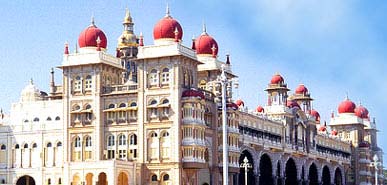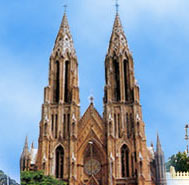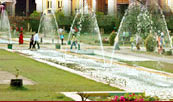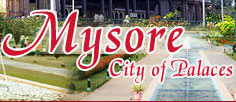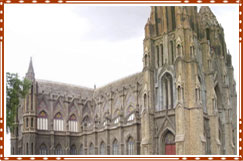 The
St. Philomena's Church in Mysore is one of the oldest churches in India.
It is over 200 years old. Initially over 250 years ago there was a small
church in its place. When the capital of Mysore state was move from
Srirangapatnam to Mysore city in 1799, many British officers and
soldiers came and settled down in Mysore. The Maharaja Krishnaraja
Wodeyar III realized the need for a Christian church for these people.
So the Maharaja gave them a small plot of land on the Mysore-Bangalore
Road and a little church came up there. As the city expanded and the
Christian population of the city increased there was a need for a larger
church.
The
St. Philomena's Church in Mysore is one of the oldest churches in India.
It is over 200 years old. Initially over 250 years ago there was a small
church in its place. When the capital of Mysore state was move from
Srirangapatnam to Mysore city in 1799, many British officers and
soldiers came and settled down in Mysore. The Maharaja Krishnaraja
Wodeyar III realized the need for a Christian church for these people.
So the Maharaja gave them a small plot of land on the Mysore-Bangalore
Road and a little church came up there. As the city expanded and the
Christian population of the city increased there was a need for a larger
church. So plans for made to build a larger church and thus came into existence the famous St. Philomena Church of Mysore. Maharaja Krishnaraja Wodeyar IV laid the foundation of the new church on October 28th, 1933 that was to be built in the place of the small church built by his grandfather. A Frenchman named Daly designed the church. The floor plan of the cathedral is in the form of a cross. The long part of the cross is the 'nave', which is the congregation hall. The two arms of the cross are the 'transepts'. The fourth part containing the altar and the choir is the 'crossing'.
The Holy Mass is performed daily in Kannada, Tamil and English at the table in the sanctum sanctorum. Behind this is an exquisite marble altar on which the statue of St. Philomena is placed. There is also an idol of Christ lying in his sacred wounds. Above the sanctum there are lovely stained glass windows from France with painting depicting the birth of Jesus Christ, the Last Supper, the Crucifixion and the Resurrection. The part of the church that is most attractive is the towers or spires. These towers resemble that of a cathedral in Cologne in Germany and those of St. Patrick's Church in New York. The two spires are 175 feet tall.
The entire church is built in the Gothic style is one of the largest Cathedrals in South Asia. The Church has the relic of the 3rd century St. Philomena that is in a beautiful catacomb that is below the main altar. The construction of the church was completed under Bishop Rene Fuga's supervision. At that time Thamboo Chetty, was the Huzur Secretary to the Maharaja of Mysore, heard about the greatness of St. Philomena and obtained a relic of the saint from Peter Pisani, Apostolic Delegate of the East Indies in 1926. After obtaining the relic it was handed over to Fr. Cochet. The next year a new state of St. Philomena was brought from France.
The story of St. Philomena dates back to the 3rd century A.D. Philomena was the daughter of the monarch of a small state in Greece. Her parents were childless. They prayed to God and asked Him to bless them with a child and promised to convert to Christianity if their wish was granted. The next year Philomena was born to them. Even in her childhood Philomena showed signs of piety. When Philomena was 13 years' old her father took her to Rome to obtain the favour of Emperor Diocletion. The Emperor was enthralled by her beauty and wanted to marry her. But she refused and vowed to give herself to God. As she refused to marry the Emperor she was tortured and beheaded in Rome.
But people's devotion for her spread near and far and she was given sainthood. There are a number of churches dedicated to her all over the world. Today the church stands as a monument to the secular outlook of the Mysore rulers. It is no longer just a religious place but has become a major tourist attraction in Mysore. There is an orphanage on the premises of the church that is run by the church. The church is located at a distance of 3kms from the city bus stand and 2km from the Palace. The church is open from 8am to 6pm. Holy Mass is held in the morning and evening. Special masses are held on Sundays and on festivals. An Annual Feast is held on August 11th each year.
